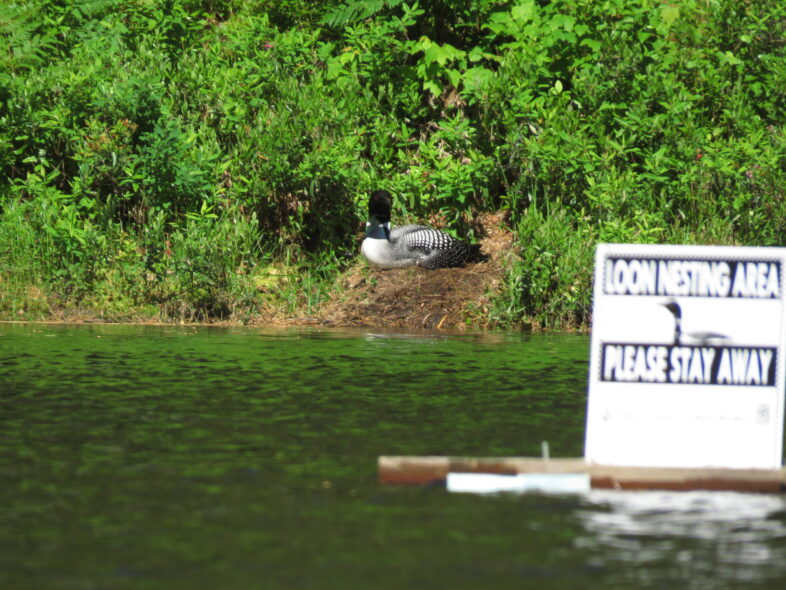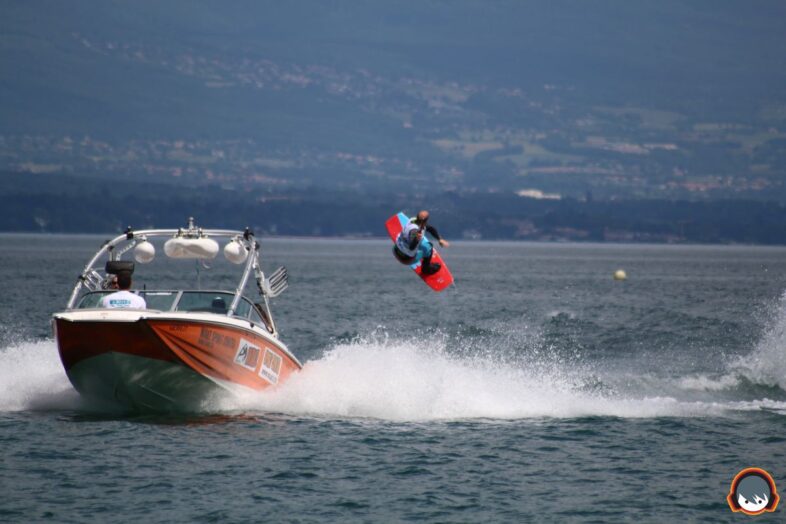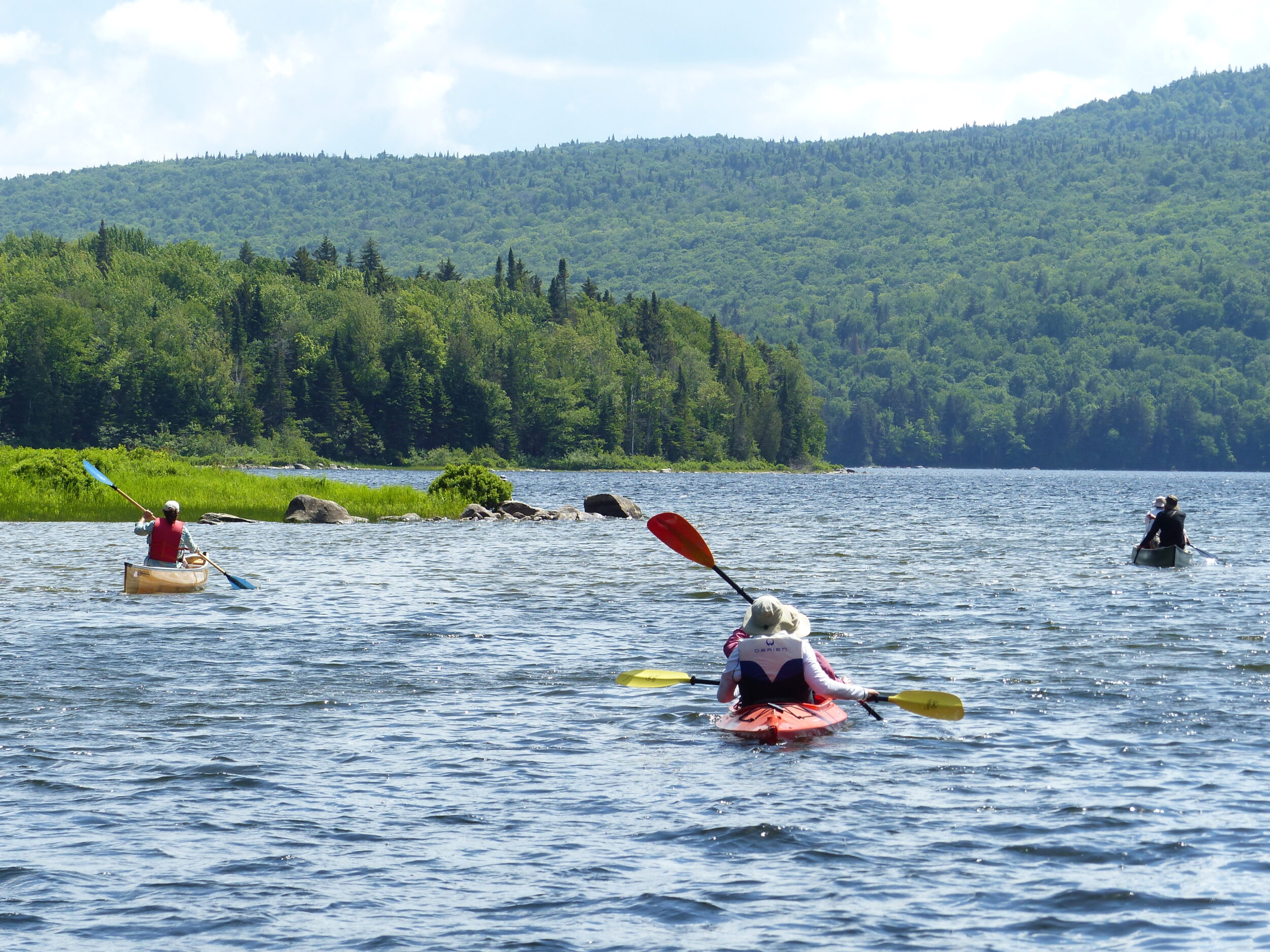
Loon nests are often located only inches above the water line, making them vulnerable to large waves. © Nicki Steel
Summer on Vermont’s lakes comes with many joys—quiet afternoons paddling, tranquil mornings fishing, hazy hot days swimming and tubing, and the discovery of loon nests with one or two precious eggs being incubated by their parent.
However, people and loons alike are contending with a presence that can turn typically calm waters into choppy, ocean-sized (and sometimes dangerous) waves.
For the past few years, a debate has swirled among outdoor recreationists, waterfront owners, and conservationists: where should wakeboats be allowed on Vermont’s waters?
Wakeboats are specialized motorboats that have ballast tanks and other features that increase the size of their wakes for wakeboarders to ride. These large waves can contribute to shoreline erosion, disrupt wildlife, and create hazardous conditions for boaters and swimmers nearby.

Wakeboats and wakeboarding rose in popularity during the early 2000s. Public Domain image, no copyright
As of April 2024, the state’s Use of Public Waters Rules designated “wakesports zones” as a minimum of 50 contiguous acres that are at least 500 feet from shore on all sides, at least 20 feet deep, and at least 200 feet wide. Wakeboats are prohibited on lakes, ponds, and reservoirs that do not meet these criteria.
Many Vermonters worry that the existing rules are not restrictive enough. Last year, community members submitted petitions to prohibit wakeboats on 11 waterbodies, and VCE Loon Biologist Eric Hanson submitted comments in support of the petitions because wakesports pose grave threats to nesting loons on these lakes.
The Vermont Department of Environmental Conservation rejected these petitions, opting instead to develop a new rule for all lakes and ponds that attempts to address the petitioners’ concerns. One of the most substantial changes increases the zone size from a minimum of 50 contiguous acres to a minimum of 100 contiguous acres.
Despite the new rule’s stricter guidelines and inclusion of a 500-foot buffer around loon nests, we are still worried about wakeboats’ impacts on loon nest sites. Even wakeboats operating legally, within the updated boundaries, risk destroying nests. At 500 feet, a wakeboat has the equivalent impact that a standard motorboat would from just 50 feet away, producing a wave five to six inches tall. Waves of this height would likely flood all loon nests that are directly exposed to wakesport zones, washing away eggs or drowning young chicks. Even nests that are currently far from wakesport zones could be moved into harm’s way since loons often change nesting locations.
The challenges of enforcing these buffer zones with immediacy could present additional threats for loons. Loon nests—whether on shorelines or specialized nesting rafts—are usually located two to eight inches above the water level. Wakeboats that get closer than 500 feet could produce waves in excess of eight to ten inches. Even just one wakeboat straying too close to shore would swamp any nest present and cause it to fail. Irreversible damage would be done before law enforcement could respond.
Not all of wakeboats’ effects on loons are direct. Larger waves promote greater shoreline erosion, increasing turbidity and nutrient loads. Healthy lakeshores and clear waters are critical for the base of aquatic food webs, on which plants, insects, fish, and loons all depend. When the water is cloudy, catching prey becomes more difficult, especially for loon chicks. In Wisconsin, a recent study has shown that chick survival has declined over the past 25 years, partly due to decreases in water clarity. Here in Vermont, we know of at least one chick death connected to decreased visibility after the July 2023 flooding.

Paddlers enjoy a sunny afternoon on the water. © Eric Hanson
Loon watching is only one of many activities that draw visitors to Vermont’s shores each summer, and wakeboating impacts everyone recreating on the lake, including paddlers, fishermen, and others seeking connection with nature. By disrupting these outdoor pursuits, wakeboats risk discouraging people from engaging with and learning from our state’s aquatic ecosystems, activities that inspire long-term environmental stewardship.
Allowing wakeboats to operate without establishing wider buffers could jeopardize the recovery of Vermont’s once-endangered Common Loon, a species that has rebounded thanks to years of tremendous dedication and hard work.
If you want to learn more about the new rule and DEC’s rulemaking process, visit https://dec.vermont.gov/watershed/lakes-ponds/lakes-and-ponds-rulemaking.

Pingbacks (1)
[…] Per Vermont Center for Ecostudies expert statement on Aug 6, 2025, RWVL supports an increase from the current 300 ft but we recommends 700 ft. […]